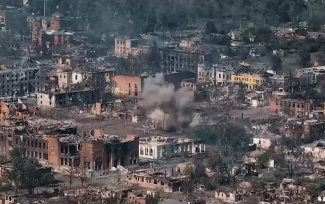Zelensky dismisses the commander of the Ukrainian army’s Combined Forces. Day 852 of the war


On 19 June, the Russians struck from Horlivka towards Toretsk, where the last remaining section of the 2014 demarcation line to remain intact in the Donbas ran. Within a few days they broke through the first lines of the Ukrainian fortifications; they emerged on the outskirts of the Druzhba and Pivnichni (Kirove) districts, which are part of the Toretsk conurbation, and also seized the village of Shumy, which lies between it and Horlivka. Toretsk, as the direct hinterland of this section of the front, was targeted by air attacks and artillery shelling, which underpinned the decision to accelerate the evacuation of its inhabitants. The invaders have been making advances along the other sections of the front in the Donbas, where the most fierce clashes are taking place, but these have not made any significant changes to the overall situation: the defenders are still holding out in the western part of the so-called Kanal micro-region of Chasiv Yar, on the outskirts of Novooleksandrivka (according to some sources, the Russians have pushed back the Ukrainian forces and are continuing their push towards the Pokrovsk-Kostiantynivka route), and in the northern part of Krasnohorivka.
The Ukrainians counter-attacked in the area of the village of Lyptsi, north of Kharkiv, and on the outskirts of Vovchansk, where they made minor gains on the ground. However, further areas in the northern part of this town came under the control of the invaders. Having secured a significant numerical advantage over the Russians – the defenders’ grouping is now estimated at around 40,000 troops, against an enemy force of 10,000 – the Ukrainians attempted to retake the areas they had lost in May. However, the lack of visible progress and the losses suffered by the Ukrainian forces in a series of assaults on enemy positions have contributed to an open outbreak of discontent. This was expressed in a request on 23 June from the chief of staff of the Azov brigade, Bohdan Krotsevych, to the State Investigation Bureau of Ukraine to prosecute a senior commander who, in his words, “had killed more Ukrainian soldiers than any Russian general”. Mariana Bezuhla, a parliamentary deputy for the ruling Servant of the Nation party who speaks on military affairs, revealed that the individual in question was General Yuri Sodol, who had been appointed as commander of the Ukrainian army’s Combined Forces in February this year. He was alleged to have previously demonstrated his incompetence in Mariupol, Krynki, Avdiivka and Ocheretyne. On the evening of 24 June, President Volodymyr Zelensky dismissed him and appointed General Andriy Hnatov in his place. Both men rose through the ranks from the naval infantry; Hnatov is regarded as a protégé of Sodol.

The invaders carried out further attacks on Ukrainian energy infrastructure, albeit on a smaller scale than before. On 19 June, Russian drones damaged energy installations in the Kirovohrad and Lviv oblasts (a scientific research institute in Lviv was also hit); a day later, missiles and drones were used to strike targets in the Dnipropetrovsk (including Dnipro city), Donetsk (a thermal power plant in Slovyansk was hit), Kyiv and Vinnytsia oblasts; and on 22 June the Lviv and Zaporizhzhia oblasts. In the last of these attacks, the National Technical Oil & Gas Institute in Ivano-Frankivsk was also reportedly damaged. In the immediate vicinity of the defenders, the Russians again intensified their strikes on Kharkiv city; targeted aerial bombs fell there at least once a day between 19 and 25 June (with the exception of the 20th). There were civilian casualties on 22 June: two people were killed and 53 wounded. Russian rockets struck the city of Odesa and its environs three times (21, 22 and 24 June) and Kryvyi Rih twice (21 and 22 June; military storage depots were the most likely targets), as well as the airfields at Mirhorod in Poltava oblast (19 June) and Vasylkiv in Kyiv oblast (23 June). In total, from the evening of 18 June to the morning of 25 June, the invaders were reported to have used 51 missiles, 20 of which the defenders claimed to have shot down. The Ukrainian Air Force Command once again announced a 100 per cent success rate against Shahed drones (40 were destroyed), but its reports did not include any local information on whether the enemy had used more Shaheds.
On 20 June, the Russians made what was probably their first use of the heaviest three-tonne M-54 (FAB-3000) guided aerial bomb (in Russian: UMPK). They attacked a Ukrainian location point at Lyptsi, north of Kharkiv. The Ukrainian Air Force Command announced that it was unable to confirm this information until the remains had been examined. In the following days, footage emerged of two other instances of the UMPK FAB-3000 being used in combat. Production of bombs of this weight was due to have resumed in Russia this February.

On 21 June, there was another massive Ukrainian drone attack on Crimea and Krasnodar krai, but it was not confirmed to have had any significant effect. The Russians stated that they had shot down 114 kamikaze drones (including 70 over Crimea) and destroyed six surface drones. While repelling the attack the Russians shot down one of their own Ka-29 helicopters, whose task was to detect and destroy surface drones. According to the Ukrainian side, the Afipsky, Ilsky, Krasnodar and Astrakhan refineries were attacked, as were radiolocation stations and radio-electronic warfare facilities. The only confirmed hit was reported at the airfield at Yeysk in Krasnodar krai: satellite imagery showed damage to a barracks building and a nearby hangar. In contrast, according to the Ukrainian Naval Command, a warehouse containing 120 Shaheds was destroyed at the training ground of the 726th Air Defence Training Centre in Krasnodar krai. An attack on Russian fuel infrastructure facilities carried out the day before was more effective. Fires were started in a tank at the Afipsky refinery and in two tanks at the Platonov fuel base in Tambov oblast, and damage was caused to a building and warehouse at the fuel base at Enem in Adygea.
As a result of the failed Ukrainian attack on Crimea on 23 June, one ATACMS missile with a cluster warhead exploded at beach level near Sevastopol, most likely after it triggered the Russian air defences. According to local Russian data, four people were killed and 153 injured. The only military effect of the hit was the traces of a fire in the open area of the Space Communications Centre (the 40th Command & Measurement Complex of the Russian Air and Space Forces) near Yevpatoria. Moscow decided to use the event as a propaganda strike against the United States, which met with pushback from Washington. The US representative stated that Kyiv was attempting to minimise civilian casualties anyway, the complete opposite of what Russia has been doing. Questions were raised in the Western media (including the Times) as to whether the large number of civilian casualties at the resort would once again lead to the West restricting Ukraine’s freedom to use the armaments it has received from them.

Romania (20 June) and the Netherlands (21 June), in cooperation with another undisclosed country, announced the delivery of further Patriot systems to Ukraine. No details were given. All that is known is that the Netherlands will send some of the battery components, which will be replenished by another country. On 20 June, Washington announced that Ukraine would be given priority for deliveries of missile for Patriot and NASAMS systems, pushing the orders placed by other countries down the queue. On 24 June, Spain announced it would deliver Kyiv a batch of previously promised Patriot missiles. On 18 June the Italian foreign minister Antonio Tajani announced the delivery of his country’s ninth support package of the SAMP-T air defence system batteries. He made no reference to earlier media reports that Italy could also send Storm Shadow cruise missiles. Denmark’s 19th support package, announced on 19 June, focuses on funding Ukrainian arms production and joint ventures with the allies, among which the supply of equipment for F-16 fighter jets has been specified.
During the Eurosatory arms fair in Paris (17-21 June), Ukrainian companies signed six cooperation documents which include future investments in the country. Two agreements with Ukroboronprom and one with FRDM, which is part of the Ukrainian Armaments Industry consortium, were concluded by France’s Thales. With Ukroboronprom it plans to create a joint venture in Ukraine for the production of radio-electronic warfare systems, air defence systems & radars, and tactical communications equipment, as well as servicing the equipment supplied and providing specialised training in this field. It intends to co-operate with FRDM in the field of developing and manufacturing unmanned aerial vehicles. In addition, Ukroboronprom has signed agreements with Arquus (for the operation and modernisation of armoured weapons), Exail (for the use of navigation systems in Ukrainian-made radars) and Hexadron (for the joint production of drones).
US media have reported that Washington is expected to announce another military aid package on 25 June. It is expected to be worth $150 million and will consist of HIMARS launcher missiles, 155-mm and 105-mm artillery ammunition, anti-tank missiles and small arms. When speaking off the record, US officials were unwilling to disclose whether further ATACMS missiles would be included in the package, but indicated that cluster munitions would not be donated.

The army will receive additional funding. On 18 June, the Ukrainian parliament adopted legislative amendments allowing local government bodies to provide financial support to military units during the period of martial law. Local budgets will be used to buy drones, pickups, spare parts for vehicles and medical equipment. In addition, with the approval of the Ministry of Defence, local governments (in frontline or border areas) will be able to contribute to the construction of fortifications and other protective facilities. At the same time, due to the army’s growing needs, the government is considering raising the rates of VAT.
On 21 June the head of the Ukrainian Interior Ministry, Ihor Klymenko, stated that it was impossible to mobilise and send all law enforcement officers to the front. Some police officers cannot be conscripted into the army because 17,000 of them have not reached the mobilisation age of 25. The minister added that a large number of officers (25,000) are already performing duties in the frontline zone, and the police assault brigades supporting the armed forces number more than 6000 men. A further 5000 police officers are supporting the border service, including on the border with Belarus.
On 25 June, the Ukrainian defence ministry reported that since the new mobilisation regulations came into force on1 8 May, 2.3 million Ukrainians had updated their data at military commissions through the ‘Reserve+’ application. Some 1.1 million of them have been declared fit for service.

On 18 June, the independent Russian portal Mediazona reported that since the announcement of mobilisation in September 2022, more than 10,000 criminal cases of refusal to perform military service have been submitted to military courts. More than 8500 people have already been convicted. The number of proceedings initiated is also increasing. In May this year, 929 cases related to unauthorised abandonment of a military unit, desertion or refusal to obey an order were brought before the courts. Most often the judges have been handing down suspended sentences, which allows the command to send the convicted individual back to the front.
There has been a major demonstration of force by Belarus. On 21 June, the General Staff of the Belarusian Armed Forces Pavel Muravieyko announced the start of an exercise to test the combat readiness of military units based in the Gomel and Brest oblasts. A day earlier, the local border service had reported an increase in the number of Ukrainian army groupings near the border. In response a representative of the Ukrainian border service, Andriy Demchenko, admitted that the army was increasing its defence capabilities in the area.

The social costs of the war are increasing. On 21 June, interior minister Klymenko stated that the number of cases of domestic violence had increased since the beginning of the year. According to him, 60% of the perpetrators are soldiers returning from the front. As he put it, one of the main reasons for the worsening situation is the lack of any proper organisation for the psychological rehabilitation of servicemen.
On 25 June the Security Service of Ukraine, in cooperation with the State Bureau of Investigation, reported that they had foiled an attempt to smuggle men evading military service en masse across the border in Odesa. On 21 June, more than 100 people intended to illegally cross the border into Moldova and Romania. The smugglers charged between $5000 and $18,500 for their ‘services’, and now face up to nine years in prison.





